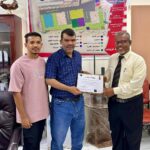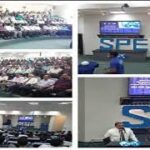Electronic Engineering and Communication Department
Overview:
Electronic Engineering and Communication Department was established in the academic year 1996–1997, coinciding with the founding of Hadhramout University.
The department is distinguished by its excellent laboratory capabilities. It is equipped with advanced labs containing numerous laboratory devices that students are trained to use for their scientific research and graduation projects.
The department also has computer labs equipped with specialized software, recognizing the importance of preparing students to use essential programs in their field of study to ensure that graduates are well-prepared to participate effectively in the modern technological era.
The duration of study in the department is five academic years, after which students are awarded a Bachelor’s degree in Electronic Engineering and Communication upon successful completion of all requirements and examinations. The curriculum includes both fundamental and applied courses in materials and electronic circuits, electrical circuits, digital logic, digital system design, digital electronics, electromagnetic waves, electric motors, communication systems, optoelectronics, control systems, microprocessors, communication transmission and exchange, digital communications, and microwave communications.
The department emphasizes the use of specialized scientific software and integrates theoretical knowledge with practical application through field visits to factories, companies, and institutions, as well as hands-on training in departmental labs and external organizations.
Graduates of the department are qualified to work in designing, developing, maintaining, and managing various communication systems, solving interference problems, managing engineering projects, analyzing costs, designing, developing, and maintaining advanced communication systems and networks, including antenna systems, satellite communications, digital communications, and signal processing systems. They are also capable of designing and maintaining electronic circuits and systems used in communication, control, computing, and other civilian or military systems.
Mission
To prepare distinguished engineers at the local and regional levels in the field of electronic engineering and communication, conduct scientific research, keep pace with scientific and professional developments, serve the community through quality programs, foster creativity and innovation in the field of specialization, and strengthen partnerships with relevant institutions.
Vision
Objectives
- To provide students with theoretical and practical foundations in basic sciences and electronic engineering and communication.
- To equip students with skills to handle electronic devices and communication systems.
- To develop students’ skills in preparing research and professional reports and solving problems in electronic engineering and communication systems to support development and community service.
- To establish a scientific environment conducive to academic work in electronic engineering and communication that keeps pace with contemporary developments and addresses emerging challenges.
- To instill professional values and ethics, modern technical skills, communication abilities, and teamwork competencies in students.
- To strive for quality and support scientific research in electronic engineering and communication and strengthen partnerships with governmental institutions and related companies.
Deans of Department:
| Name | Academic Title | Period |
| Dr. Saad Othman Al-Bashir | Professor | 1996 – 1997 |
| Dr. Muthaffar Anwar Al-Naama | Professor | 1997 – 1999 |
| Dr. Raad Hamdan Zahir | Associate Professor | 1999 – 2004 |
| Dr. Widad Mahmoud Faisal | Professor | 2004 – 2005 |
| Dr. Mohammed Hamza Al-Saba | Associate Professor | 2005 – 2006 |
| Dr. Salem Nasr Mersal | Associate Professor | 2006 – 2008 |
| Prof. Fathi Mabrouk Abu Al-Einin | Assistant Professor | 2008 – 2010 |
| Dr. Salem Nasr Mersal | Associate Professor | 2010 – 2011 |
| Dr. Majdi Salem Marai | Assistant Professor | 2011 – 2012 |
| Dr. Khalid Sahl Bin Ishaq | Assistant Professor | 2012 – 2024 |
| Dr. Khalid Ali Baali | Assistant Professor | 2024 – Present |
Faculty Members and Their Specializations:
| No. | Name | Academic Title | Notes |
| 1 | Dr. Khalid Ali Ahmed Baali | Assistant Professor | Dean of Department |
| 2 | Prof. Widad Mahmoud Faisal | Professor | |
| 3 | Dr. Abdulbaqi Ali Naji Al-Houthari | Associate Professor | |
| 4 | Dr. Saeed Ali Saeed Bin Ajaj | Assistant Professor | |
| 5 | Dr. Majdi Salem Saeed Marai | Assistant Professor | |
| 6 | Dr. Hisham Abdullah Ahmed Bakarman | Assistant Professor | |
| 7 | Dr. Khalid Sahl Bin Amer Bin Ishaq | Assistant Professor | |
| 8 | Dr. Abdullah Omar Ali Al-Dhaibani | Assistant Professor | |
| 9 | Dr. Abdullah Mohammed Abdullah Bahassan | Assistant Professor | |
| 10 | Dr. Sameer Salem Omair Al-Buri | Assistant Professor | |
| 11 | Dr. Majid Abdullah Karama Al-Dhaibi | Assistant Professor | |
| 12 | Mr. Abdulqader Mohammed Al-Ghulam Al-Amoudi | Lecturer | |
| 13 | Mr. Ahmed Ali Ahmed Bahashwan | Lecturer | |
| 14 | Assistant Lecturer Saeed Saleh Mubarak Bin Fadl | Assistant Lecturer | |
| 15 | Mr. Abdulmonem Rabee Mubarak Bashayot | PhD | Scholarship student |
| 16 | Assistant Lecturer Saleh Talib Salem Basuimi | PhD | Scholarship student |
| 17 | Mr. Abdullah Ashour Mohammed Subeih | PhD | Scholarship student |
البرامج العلمية
الخطة الدراسية لقسم الهـنـدسـة الالكـترونية والاتصالات
برنامج بكالوريوس تخصص إلكترونية واتصالات
المقررات الاختيارية:
يتم اختيار 12 ساعة معتمدة من المقررات التالية:
| ت | اسم المقرر | الرمز | Actual
الساعات الفعلية |
Credit
الساعات المعتمدة |
Code | Course Title | ||
| t
ت |
P
ع |
T
ن |
||||||
| 1 | الاتصالات الخلوية | هـات 513 | 0 | 0 | 3 | 3 | ECE513 | Cellular Communication |
| 2 | نظرية معلومات وتشفير | هـات 514 | 0 | 0 | 3 | 3 | ECE514 | Information Theory and Coding |
| 3 | معالجة الصور الرقمية | هـات 515 | 0 | 0 | 3 | 3 | ECE515 | Digital Image processing |
| 4 | تصميم انظمة التجكم الدقيق | هـات 516 | 0 | 0 | 3 | 3 | ECE516 | Microcontroller System design |
| 5 | تصميم الدوائر المتكاملة | هـات 517 | 0 | 0 | 3 | 3 | ECE517 | Integrated Circuit Design |
| 6 | هندسة الراديو والتلفزيون | هـات 523 | 0 | 0 | 3 | 3 | ECE523 | Radio And Television Engineering |
| 7 | هندسة الموجات الصوتية | هـات 524 | 0 | 0 | 3 | 3 | ECE524 | Acoustics Engineering |
| 8 | النمذجة والمحاكاة | هـات 525 | 0 | 0 | 3 | 3 | ECE525 | Modeling and Simulation |
| 9 | تصميم دوائر الـ VLSI | هـات 526 | 0 | 0 | 3 | 3 | ECE526 | VLSI Design |
| 10 | التحكم المنطقي المبرمج | هـات 527 | 0 | 0 | 3 | 3 | ECE527 | PLC |
| 11 | الاتصالات الضوئية | هـات 528 | 0 | 0 | 3 | 3 | ECE528 | Optical Communication |
السنة الأولى – الفصل الأول – الفصل رقم 1
| ت | اسم المقرر | الرمز | Actual
الساعات الفعلية |
Credit
الساعات المعتمدة |
Code | Course Title | ||
| t
ت |
P
ع |
T
ن |
||||||
| 1 | لـغـة عـربــيــة 1 | عرب 111 | 0 | 0 | 2 | 2 | ARAB 111 | Arabic Language I |
| 2 | لـغـة انـجـلـيـزيـة 1 | نجل 112 | 0 | 0 | 2 | 2 | ENG 112 | English Language I |
| 3 | ثـقـافـة إسـلامـيـة 1 | سلم 113 | 0 | 0 | 2 | 2 | ISLAM 113 | Islamic Culture I |
| 4 | مـهـارات الـحـاسـب | عال114 | 0 | 2 | 1 | 2 | CSC 114 | Computer Skills |
| 5 | حـسـاب الـتـفـاضـل | ريض 115 | 2 | 0 | 2 | 3 | MATH 115 | Differential Calculus |
| 6 | فـيـزيـاء عــامـة 1 | فيز 116 | 0 | 2 | 2 | 3 | PHYS 116 | General Physics I |
| 7 | كـيـمـيـاء عـامـة 1 | كيم 117 | 0 | 2 | 2 | 3 | CHEM 117 | General Chemistry |
| المجموع | 2 | 6 | 13 | 17 | SUB-TOTAL | |||
| الإجمالي | 21 | 17 | TOTAL | |||||
ن: نظري ع: عملي ت: تمارين T: theoretical P: practical t: tutorial
السنة الأولى – الفصل الثاني – الفصل رقم 2
| ت | اسم المقرر | الرمز | Actual
الساعات الفعلية |
Credit
الساعات المعتمدة |
Code | Course Title | ||
| t
ت |
P
ع |
T
ن |
||||||
| 1 | لـغـة عـربـيــة 2 | عرب 121 | 0 | 0 | 2 | 2 | ARAB121 | Arabic Language II |
| 2 | لـغـة انـجـلـيـزيـة 2 | نجل 122 | 0 | 0 | 2 | 2 | ENG 122 | English Language II |
| 3 | ثـقـافـة إسـلامـيـة 2 | سلم 123 | 0 | 0 | 2 | 2 | ISLAM 123 | Islamic Culture II |
| 4 | حـسـاب الـتـكـامـل | ريض 124 | 2 | 0 | 2 | 3 | MATH124 | Integral Calculus |
| 5 | فـيـزيـاء عـامـة 2 | فيز 125 | 0 | 2 | 2 | 3 | PHYS125 | General Physics II |
| 6 | بـرمـجـة الـحـاسـب | هـحا 126 | 0 | 2 | 2 | 3 | COE126 | Computer Programming |
| 7 | رسـم هـنـدسـي | تعم 127 | 2 | 0 | 1 | 2 | GE121 | Engineering Drawing |
| المجموع | 4 | 4 | 13 | 17 | SUB-TOTAL | |||
| الإجمالي | 21 | 17 | TOTAL | |||||
ن: نظري ع: عملي ت: تمارين T: theoretical P: practical t: tutorial
السنة الثانية – الفصل الأول – الفصل رقم 3
| ت | اسم المقرر | الرمز | Actual
الساعات الفعلية |
Credit
الساعات المعتمدة |
Code | Course Title | |||
| t
ت |
P
ع |
T
ن |
|||||||
| 1 | عـلـم الـمــواد | هـات 211 | 0 | 0 | 2 | 2 | ECE211 | Material Science | |
| 2 | الـدوائـر الـكـهـربـائية (1) | هـات 212 | 2 | 2 | 2 | 4 | ECE212 | Electric Circuit (1) | |
| 3 | الـمـنـطـق الـرقـمـي | هـات 213 | 1 | 2 | 2 | 3 | ECE213 | Digital Logic | |
| 4 | مـبـادئ قـواعـد بـيـانـات | هـحا 224 | 0 | 2 | 2 | 3 | COE224 | Data Structure & Algorithms | |
| 5 | عـلـم الـسـكـون | هــمد 215 | 0 | 0 | 2 | 2 | CE215 | Statics | |
| 6 | المـتـجـهـات والمصفوفـات | ريض 216 | 2 | 0 | 2 | 3 | MATH216 | Vectors and Matrices | |
| المجموع | 5 | 6 | 12 | 17 | SUB-TOTAL | ||||
| الإجمالي | 23 | 17 | TOTAL | ||||||
ن: نظري ع: عملي ت: تمارين T: theoretical P: practical t: tutorial
السنة الثانية – الفصل الثاني – الفصل رقم 4
| ت | اسم المقرر | الرمز | Actual
الساعات الفعلية |
Credit
الساعات المعتمدة |
Code | Course Title | ||
| t
ت |
P
ع |
T
ن |
||||||
| 1 | مـهـارات الاتـصـال | اجت 221 | 0 | 0 | 2 | 2 | SSS 221 | Communication Skills |
| 2 | الاجـهـزة الالـكـتـرونـيـة | هـات 222 | 0 | 2 | 2 | 3 | ECE222 | Electronic Devices |
| 3 | تـصـمـيـم نـظـم رقـمـية | هـات 223 | 0 | 2 | 2 | 3 | ECE223 | Digital System Design |
| 4 | نـظـريـة الكهرومغناطيسية | هـات 224 | 1 | 0 | 3 | 3 | ECE224 | EM Theory |
| 5 | الـدوائـر الـكـهـربائـية 2)) | هـات 225 | 1 | 2 | 2 | 3 | ECE225 | Electrical Circuits (2) |
| 6 | مـعـادلات تـفـاضـلـيـة | ريض 226 | 2 | 0 | 2 | 3 | MATH226 | Differential Equation |
| المجموع | 4 | 6 | 13 | 17 | SUB-TOTAL | |||
| الإجمالي | 23 | 17 | TOTAL | |||||
ن: نظري ع: عملي ت: تمارين T: theoretical P: practical t: tutorial
السنة الثالثة – الفصل الأول – الفصل رقم 5
| ت | اسم المقرر | الرمز | Actual
الساعات الفعلية |
Credit
الساعات المعتمدة |
Code | Course Title | ||
| t
ت |
P
ع |
T
ن |
||||||
| 1 | الاجـهـزة والـقـيـاسـات | هـات 311 | 0 | 2 | 2 | 3 | ECE311 | Instrumentation and Measurements |
| 2 | دوائـر الـكـتـرونـيـة | هـات 312 | 1 | 2 | 2 | 3 | ECE312 | Electronic Circuits |
| 3 | اشـارات ونـظـم | هـات 313 | 1 | 0 | 3 | 3 | ECE313 | Signals & Systems |
| 4 | المـحـركـات الـكـهـربـائـيـة | هـات 314 | 0 | 2 | 2 | 3 | ECE314 | Electrical Machines |
| 5 | الموجات الكهرومغناطيسية | هـات 315 | 1 | 0 | 3 | 3 | ECE315 | EM-Waves |
| 6 | احصاء واحتمالات هندسية | ريض 316 | 2 | 0 | 2 | 3 | MATH316 | Engineering Probability and Statistics |
| المجموع | 5 | 6 | 14 | 18 | SUB-TOTAL | |||
| الإجمالي | 25 | 18 | TOTAL | |||||
ن: نظري ع: عملي ت: تمارين T: theoretical P: practical t: tutorial
السنة الثالثة – الفصل الثاني – الفصل رقم 6
| ت | اسم المقرر | الرمز | Actual
الساعات الفعلية |
Credit
الساعات المعتمدة |
Code | Course Title | ||
| t
ت |
P
ع |
T
ن |
||||||
| 1 | الـكـتـرونـيـات رقـمـيـة | هـات 321 | 0 | 2 | 2 | 3 | ECE321 | Digital Electronics |
| 2 | الالكترونيات الضوئية | هـات 322 | 1 | 0 | 3 | 3 | ECE322 | Opto-electronics |
| 3 | أنـظـمـة تـحـكــم | هـات 323 | 1 | 2 | 2 | 3 | ECE323 | Control Systems |
| 4 | أنـظـمـة اتـصـالات 1 | هـات 324 | 0 | 2 | 3 | 4 | ECE324 | Communications Systems (1) |
| 5 | طـرق عــدديــة | ريض 325 | 2 | 0 | 2 | 3 | MATH325 | Numerical Methods |
| 6 | كـتـابـة تـقـنـيـة | نجل 326 | 0 | 0 | 2 | 2 | ENG326 | Technical Writing |
| المجموع | 4 | 6 | 14 | 18 | SUB-TOTAL | |||
| الإجمالي | 24 | 18 | TOTAL | |||||
ن: نظري ع: عملي ت: تمارين T: theoretical P: practical t: tutorial
السنة الرابعة – الفصل الأول – الفصل رقم 7
| ت | اسم المقرر | الرمز | Actual
الساعات الفعلية |
Credit
الساعات المعتمدة |
Code | Course Title | ||
| t
ت |
P
ع |
T
ن |
||||||
| 1 | أسس البحث العلمي | هـات 411 | 0 | 0 | 2 | 2 | ECE411 | Principles of Scientific Research |
| 2 | أنـظـمـة اتـصـالات (2) | هـات 412 | 0 | 2 | 2 | 3 | ECE412 | Communications Systems (2) |
| 3 | مـعـالـجـة اشارة رقمية | هـات 413 | 1 | 0 | 3 | 3 | ECE413 | Digital Signal Processing |
| 4 | هــوائـيـــات | هـات 414 | 0 | 2 | 2 | 3 | ECE414 | Antennas |
| 5 | الـدوائـر الالـكـتــرونـيـة للاتـصـالات | هـات 415 | 1 | 2 | 2 | 3 | ECE415 | Electronic Communication Circuits |
| 6 | مـعـمـارية حـاسـوب | هـحا 416 | 0 | 2 | 2 | 3 | COE416 | Computer Architecture |
| المجموع | 2 | 8 | 13 | 17 | SUB-TOTAL | |||
| الإجمالي | 23 | 17 | TOTAL | |||||
ن: نظري ع: عملي ت: تمارين T: theoretical P: practical t: tutorial
السنة الرابعة – الفصل الثاني – الفصل رقم 8
| ت | اسم المقرر | الرمز | Actual
الساعات الفعلية |
Credit
الساعات المعتمدة |
Code | Course Title | ||
| t
ت |
P
ع |
T
ن |
||||||
| 1 | اقـتـصـاد هـنـدسـي | هـات 421 | 0 | 0 | 2 | 2 | ECE421 | Engineering Economy |
| 2 | الـتـراسـل وتـبـادل الاتـصــالات | هـات 422 | 1 | 0 | 3 | 3 | ECE422 | Telecommunication Transmission & Switching |
| 3 | اتـصــالات رقـمـيـة | هـات 423 | 1 | 2 | 2 | 3 | ECE423 | Digital Communication |
| 4 | اتـصـالات مـيـكـرويـف | هـات 424 | 1 | 2 | 2 | 3 | ECE424 | Microwave Communications |
| 5 | أنـظـمـة مـعـالـجة دقيقة | هـحا 426 | 0 | 2 | 2 | 3 | COE426 | Microprocessor Systems |
| 6 | أخـلاقـيـات الـمـهـنـة | تعم427 | 0 | 0 | 2 | 2 | GE427 | Professional Ethics |
| 7 | تـدريـب مـيــدانـي | هـات 425 | 0 | 0 | 0 | 0 | ECE425 | Practical training |
| المجموع | 3 | 6 | 13 | 16 | SUB-TOTAL | |||
| الإجمالي | 22 | 16 | TOTAL | |||||
ن: نظري ع: عملي ت: تمارين T: theoretical P: practical t: tutorial
السنة الخامسة – الفصل الأول – الفصل رقم 9
| ت | اسم المقرر | الرمز | Actual
الساعات الفعلية |
Credit
الساعات المعتمدة |
Code | Course Title | ||
| t
ت |
P
ع |
T
ن |
||||||
| 1 | شـبـكـات الحـاسـب | هـات 511 | 1 | 0 | 3 | 3 | ECE511 | Computer Networks |
| 2 | مـشـروع تـخـرج 1 | هـات 512 | 0 | 4 | 0 | 2 | ECE512 | Graduation Project 1 |
| 3 | مـادة اخـتـيـاريـة 1 | هـات 51x | 0 | 0 | 3 | 3 | ECE51x | Elective-1 |
| 4 | مـادة اخـتـيـاريـة 2 | هـات 51x | 0 | 0 | 3 | 3 | ECE51x | Elective-2 |
| المجموع | 1 | 4 | 9 | 11 | SUB-TOTAL | |||
| الإجمالي | 14 | 11 | TOTAL | |||||
ن: نظري ع: عملي ت: تمارين T: theoretical P: practical t: tutorial
السنة الخامسة – الفصل الثاني – الفصل رقم 10
| ت | اسم المقرر | الرمز | Actual
الساعات الفعلية |
Credit
الساعات المعتمدة |
Code | Course Title | ||
| t
ت |
P
ع |
T
ن |
||||||
| 1 | اتـصـالات الاقـمـار الـصـنـاعـيــة | هـات 521 | 1 | 0 | 3 | 3 | ECE521 | Satellite Communications |
| 2 | مـشـروع تـخـرج 2 | هـات 522 | 0 | 6 | 0 | 3 | ECE522 | Graduation Project 2 |
| 3 | مـادة اخـتـيـاريـة 3 | هـات 52x | 0 | 0 | 3 | 3 | ECE52x | Elective-3 |
| 4 | مـادة اخـتـيـاريـة 4 | هـات 52x | 0 | 0 | 3 | 3 | ECE52x | Elective-4 |
| المجموع | 1 | 6 | 9 | 12 | SUB-TOTAL | |||
| الإجمالي | 16 | 12 | TOTAL | |||||
ن: نظري ع: عملي ت: تمارين T: theoretical P: practical t: tutorial
الطلاب :
يبلغ عدد الطلاب المقيدون بالقسم أكثر من 400 طالب وطالبة، فيما بلغ عدد الطلاب الخريجون من القسم منذ التأسيس وحتى العام الجامعي 2022-2023 1578 طالب وطالبة.
جدول يوضح عدد الطلاب المتخرجون من قسم الهندسة الالكترونية والاتصالات منذ التأسيس وحتى العام الجامعي 2023-2024
| الدفعة | العام الجامعي | ذكر | أنثى | الدفعة | العام الجامعي | ذكر | أنثى | |
| 1 | 2000-2001 | 25 | 0 | 13 | 2012-2013 | 67 | 3 | |
| 2 | 2001-2002 | 36 | 0 | 14 | 2013-2014 | 76 | 0 | |
| 3 | 2002-2003 | 44 | 0 | 15 | 2014-2015 | 77 | 3 | |
| 4 | 2003-2004 | 62 | 0 | 16 | 2015-2016 | 81 | 9 | |
| 5 | 2004-2005 | 41 | 0 | 17 | 2016-2017 | 116 | 12 | |
| 6 | 2005-2006 | 53 | 3 | 18 | 2017-2018 | 64 | 17 | |
| 7 | 2006-2007 | 47 | 2 | 19 | 2018-2019 | 63 | 7 | |
| 8 | 2007-2008 | 49 | 1 | 20 | 2019-2020 | 63 | 7 | |
| 9 | 2008-2009 | 68 | 2 | 21 | 2020-2021 | 76 | 5 | |
| 10 | 2009-2010 | 50 | 4 | 22 | 2021-2022 | 68 | 0 | |
| 11 | 2010-2011 | 65 | 1 | 23 | 2022-2023 | 72 | 8 | |
| 12 | 2011-2012 | 52 | 3 | 24 | 2023-2024 | 69 | 7 | |
| المجموع | 592 | 16 | المجموع | 892 | 78 | |||
| الاجمالي | 1578 | |||||||








